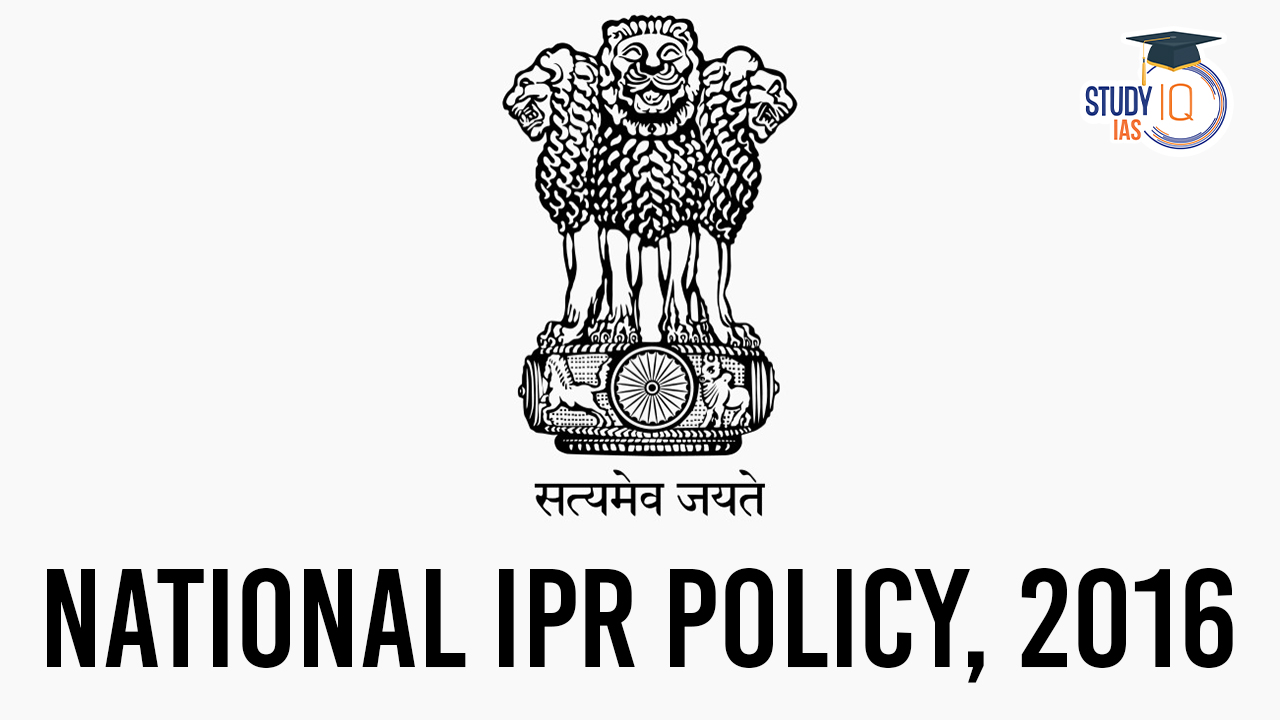Table of Contents
The National Intellectual Property Rights (IPR) Policy of 2016 in India aimed to promote innovation and creativity through a balanced IPR framework. It focused on enhancing awareness, strengthening legal mechanisms, establishing a single-window clearance system, and encouraging commercialization of intellectual property. The policy underscored the importance of effective enforcement and adjudication, along with fostering international cooperation to align with global standards while protecting India’s interests.
National IPR Policy 2016
Intellectual Property Rights (IPR) encompass patents, trademarks, copyrights, etc., providing exclusive rights to individuals or organizations for innovations. Globally, the Trade-Related Aspects of Intellectual Property Rights (TRIPS) set standards. In India, the Patent Act of 1970 and the Copyright Act of 1957 operate, with the Patent Amendment Act of 2005 aligning with TRIPS.
Despite concerns and a low international ranking, India’s National IPR Policy of 2016 aims to enhance the investment climate, foster innovation, and promote commercial exploitation of IPs, particularly in the Pharmaceutical and Information Technology sectors. The policy emphasizes awareness, positioning IPRs as valuable financial assets and economic tools.
National IPR Policy 2016 Objectives
- Create awareness about the economic, social, and cultural benefits of IPRs.
- Stimulate the generation of IPRs.
- Establish a strong legislative framework balancing the rights of IPR holders and the public.
- Modernize and strengthen IPR administration and management.
- Promote commercialization of IPR.
- Strengthen enforcement and adjudication mechanisms against infringements.
- Expand human capital through training, research, and skill development.
Features of National IPR Policy 2016
The National Intellectual Property Rights (IPR) Policy of India, enacted in 2016, incorporates several key features to foster innovation, awareness, and enforcement. Here are some of its notable features:
Innovation Promotion
- Recognizes the role of innovation and creativity in a knowledge economy.
- Equates innovation with the generation of Intellectual Properties (IPs).
Commercialization Facilitation
- Focuses on enabling the commercialization of IPs through awareness and streamlined administrative procedures.
Administrative Reforms
- Proposes bringing copyrights under the Department of Industrial Policy and Promotion for consistency.
IPR Exchange Study
- Suggests studying the feasibility of establishing an IPR exchange to facilitate investment in IP-driven industries.
Expedited Patent Examination
- Urges expedited examination of patent applications to promote manufacturing in India.
Inclusive Approach
- Addresses the rural and marginalized economy, prioritizing financial support for IP owners such as farmers and artisans.
Dispute Resolution
- Recommends the establishment of dedicated commercial courts for IP-related matters.
- Encourages exploring Alternative Dispute Resolution Mechanism for IP disputes.
Enforcement Enhancement
- Calls for enhanced coordination among government and non-government entities in enforcing IPRs.
- Encourages technology-based solutions for effective enforcement.
Additional Proposals
- Proposes criminalization of unauthorized copying of movies.
- Encourages Corporate Social Responsibility (CSR) funds for open innovation.
- Emphasizes capacity building in IPR through training, research, and skill development.
Cautionary Notes
- This raises concerns about promoting IPs as an end in itself without considering the broader innovation ecosystem.
- Cautions against linking researchers’ career progression with IP generation in publicly funded research institutions.
Benefits of National IPR Policy
The envisioned IPR policy regime presents several advantages:
Comprehensive Vision:
- Establishes a visionary plan connecting various intellectual property types, relevant laws, and government entities.
International Alignment:
- Aims to harmonize India’s IP regime with global standards, potentially elevating India’s Ease of Doing Business score.
Attraction for Investments:
- Encourages investments by fostering credibility among potential investors and strategic partners.
Efficiency Enhancement:
- Targets a reduction in processing time for the backlog of IPR applications, enhancing administrative efficiency.
Holistic Impact:
- Addresses diverse areas, including healthcare, food security, environmental protection, and anti-piracy efforts in movies and music.
Stable Administration:
- Establishes a stable, open, and service-oriented IPR administration, fostering creativity and innovation across industries.
Awareness Promotion:
- Aims to raise awareness, fostering a culture supportive of innovation and creativity, leading to commercially viable and protectable intellectual property.
Legal Framework Consolidation:
- Brings the Copyright Act and Semiconductor Integrated Circuits Layout-Design Act under the Department of Industrial Policy and Promotion (DIPP), benefiting industries and individuals.
Administrative Convergence:
- Enhances the commercial relevance of IPRs through better administrative convergence when housed under a unified structure.
Societal Awareness:
- Promotes awareness across society about the social, economic, and cultural benefits of IPRs.
Comparative Analysis of the Issues Surrounding IPR
| Issues | India | China | US/EU | TRIPS |
| Open Source Software | Open Source Software allows modification and sharing. Proprietary Software has closed source code owned by original authors. | Similar to India, recognizes Open Source, and also utilizes proprietary software. | Acknowledges Open Source; proprietary software widely used. | TRIPS doesn’t specifically address Open Source vs. Proprietary Software. |
| Compulsory Licensing (CL) | Section 84 of the Patents Act 1970 deals with it; Used for public benefit, especially in Health. | New measures introduced in 2012; Limited usage due to pro-business stance. | Strong opposition due to corporate lobbying; Strict conditions under Article 31. | TRIPS supports Compulsory Licensing under specific conditions; Patents Act Section 84 aligns with TRIPS. |
| CL Precedence | Granted CL in Bayer v/s Union of India case. | No past grants; Currently not opting for CL. | CL granted during initial years but not currently. | TRIPS supports CL, but its usage varies globally. |
| CL Arguments | Legitimate as per TRIPS; Violation of treaties; Encourages innovation. | Utilizes CL as a negotiation tool; Low usage in recent years. | Seen as against innovation; Limits investment in R&D. | TRIPS seeks a balance between patent protection and public health; grants CL under specific conditions. |
| CL Impact | May impact foreign investment; Ensures access to affordable drugs. | Limited impact due to pro-business policies; Negotiation tool. | Reluctance to engage with CL route; Focus on patents. | TRIPS aims to balance interests; Impact varies based on individual countries’ policies. |
| Evergreening | Section 3(d) of IP act addresses it; Justifies with significant improvement. | Allows evergreening; Grants patents with minor modifications. | Grants patents and allows evergreening, establishing monopolies. | TRIPS doesn’t explicitly address evergreening; Emphasizes patents for inventions without discrimination. |
| Evergreening Precedence | Yes, Novartis v/s Union of India case. | Common practice; Patents granted with slight improvements. | Commonly practiced, allowing for extended patent monopolies. | TRIPS framework allows for patents without specific mention of evergreening. |
This comparative analysis highlights the differing stances and practices regarding Open Source Software, Compulsory Licensing, and Evergreening in India, China, and the US/EU, considering their individual legal frameworks and adherence to TRIPS agreements.
National IPR Policy, 2016 UPSC
The National IPR Policy of 2016 in India aimed to boost innovation through a balanced framework, emphasizing awareness, legal strengthening, and commercialization. It aligned with global standards, acknowledging India’s robust IP structure. The policy addressed Open Source Software, Compulsory Licensing, and Evergreening, comparing practices in India, China, and the US/EU. It highlighted India’s commitment to TRIPS, balancing public and rights holders’ interests. The envisioned benefits included international alignment, efficiency enhancement, societal awareness, and a stable administration. The crux lies in fostering a comprehensive, globally aligned IPR environment, encouraging innovation while safeguarding public interests and international commitments.


 Nipah Virus (NiV): Structure, Testing Me...
Nipah Virus (NiV): Structure, Testing Me...
 What is Ham Radio and its Purpose?
What is Ham Radio and its Purpose?
 INS Udaygiri, Key Features, Capabilities...
INS Udaygiri, Key Features, Capabilities...





















